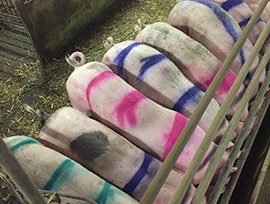Contact
Department of Applied Animal Science and Welfare (former HMH), Division of Environment, Care and Herd Health

Tail biting is a well-known issue within European pig production and its subsequent tail injuries of this abnormal behaviour is known to cause stress and reduce welfare in both the injured and biting pigs. If tail biting is detected early, management might prevent an outbreak.
In this study, researchers from the Swedish University of Agricultural Sciences assessed the tail posture of pigs during feeding, to investigate if hanging or curled tail can serve as early indicators of tail damage. There were 5713 observations of curled tails (55.4% nondamaged tails; 10.7% swollen tails; 13.6% bite marks; 19.6% tail wounds; 0.8% inflamed wounds) and 379 observations hanging tails ( 28.8% nondamaged; 7.92% swollen tails; 7.65% bite marks, 46.97% tail wounds; 8.71% inflamed wounds). Tail posture and tail damage varied, and increased with time. Hanging tails were positively associated with tail damage scores of "wound" and "inflamed wound" (p < 0.05), however not with less severe damage, i.e., "swollen" and "bite marks". Pigs with "wound" were 4.15 and pigs with "inflamed wounds" 14.24 times more likely to have hanging tails compared to pigs with nondamaged tails.
Although the causal relationship between tail posture and tail biting is not fully understood, tail position at feeding seem to be a promising sign for early detection of tail damages.
Wallgren T, Larsen A, Gunnarsson S. 2019. Tail Posture as an Indicator of Tail Biting in Undocked Finishing Pigs. Animals 9, 18.